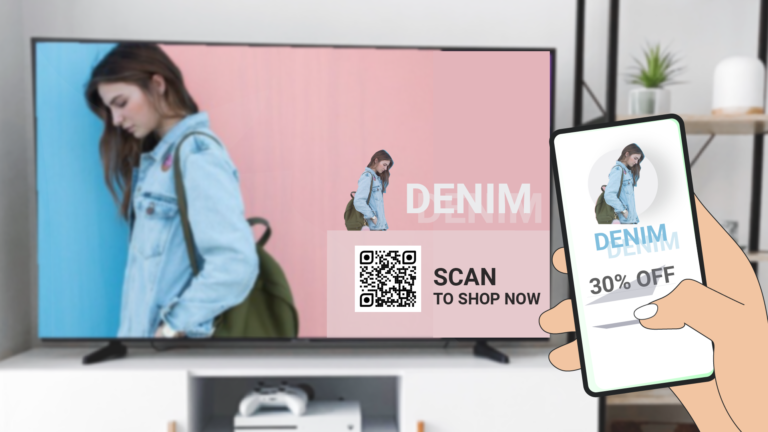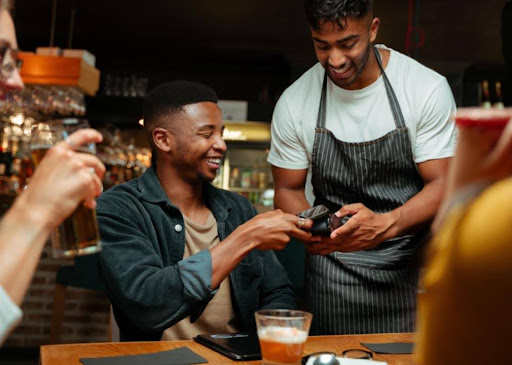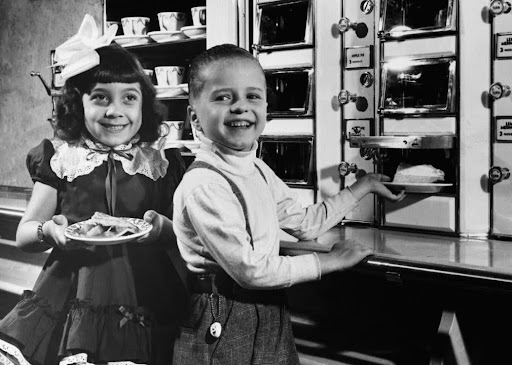There has been a 30% drop in TV usage amongst Millennials and Gen Xers as they are shifting towards streaming sites like Netflix, Hulu, and Amazon Prime.
The ones who still watch regular TV are losing engagement during commercial breaks. They tend to be distracted by other forms of content on smartphones, tablets, and other devices, so they don’t remember the TV advertisements at all.
Brands have found an effective strategy in shoppable QR Codes—a solution for brands where viewers can buy products when they see them on their TV screens.
By scanning a QR Code on TV during pre-defined shoppable moments, viewers get access to an eCommerce website of the brands.
It is common to see viewers using a ‘second screen’ while watching TV.
Utilizing this phenomenon, brands are connecting the television platform and digital platforms through QR Code ads created from QR Code generators.

We also see streaming giants and OTT platforms like Netflix assimilating these shoppable QR Codes for their marketing and advertising strategies.
To make the best of the QR Code commercials, here’s what you need to know about them and the best practices to keep in mind.
Table of Contents
- QR Codes on TV
- How do QR Code ads work?
- Second Screen marketing strategy helps shoppable TV ads
- QR Codes on TV: Best use-cases
- Shoppable TV ads for NBCU advertising
- Burger King’s shoppable tv ads include QR Codes to provide offers
- How does the QR Whopper campaign help Burger King and consumers?
- ZeeTV became a shoppable TV for Flipkart’s Big Billion day
- Future of QR Codes on TV and OTT platforms
- Why your next shoppable TV ad should feature a QR Code
QR Codes on TV
How do QR Code ads work?
Before the advent of smartphone culture, infomercials were all the rage.
Viewers were encouraged to call and purchase a product that they saw on the TV screens.
Now it is through shoppable tv ads where a viewer scans a QR Code telecasted on the TV screens through a smartphone, and the QR Code directs to an eCommerce website of the brand.
With massive competition from direct-to-customer commerce via social media, where customers are ready and willing to shop, it has influenced a change in TV advertising through QR Code commercials.
QR Codes have turned out to be a potentially easy way for brands to create a direct response on TV. The rise in QR Code usage amongst consumers has helped brands connect content and commerce.
Second Screen marketing strategy helps shoppable TV ads

QR Code ads are effective because using a ‘second screen’ has become common amongst people as they are watching TV.
When was the last time you sat in front of a TV without your phone nearby?
This trend is common across all ages, with millennials of 18-24 age groups at the top with 79% second screen usage.
Regular TV advertisements do not have the same impact on consumers with constant distractions from mobile devices. QR Codes on TV screens stand out as a massive opportunity for brands to capitalize on the second screen phenomenon. Brands can connect various media platforms to television by creating a compelling message and call-to-action.
QR Codes on TV: Best use-cases
Shoppable TV ads for NBCU advertising

NBCU’s shoppable TV connects the living room TV programs to an engaging shopping experience through a smartphone.
The company used QR Code commercials to achieve this.
A QR Code on an ad pops up on the bottom of the screen during relevant moments of a show. A viewer can point their smartphone cameras, scan these QR Codes, and get a link to a brand’s eCommerce website, where viewers can buy products.
Brands like Walmart, Lacoste, and Zwift are already using these QR Code commercials for NBCU advertising. shoppable tv ads are non-intrusive and engaging.
In some instances, NBCU explicitly lets viewers know about the QR Code ads. At other times it just shows up in the bottom-third of the screen.
During the French Open, NBCU broadcasted a shoppable TV ad of Lacoste.
During a game of Novak Djokovic playing, a QR Code ad popped up with him wearing Lacoste apparel as in the actual game. When viewers scanned the QR Code, it redirected them to the Lacoste eCommerce website where they could buy their desired product.
NBCU, during a test run of ads with QR Codes on one of its shows, received 50,000 scans in five minutes. With QR Codes on TV, NBCU resulted in an increase in conversion rate up to 30% higher than the eCommerce industry benchmark.
Burger King’s shoppable tv ads include QR Codes to provide offers

Burger King’s latest promotion, “QR Whopper” launched in April 2020.
To stay connected with their customers during the COVID-19 pandemic, Burger King placed QR Codes on its video and 3 TV advertisements.
The TV commercials included QR Codes floating around the screen.
Users had to “catch” and scan the QR Code via the Burger King app. The QR Code directed them to a Burger King website offering coupons for a free Whopper.
How does the QR Whopper campaign help Burger King and consumers?
1. Provides a gamified experience for mobile users
The promotion enables a gamified experience for users engaging them with the brand and offering a seamless way to purchase meals via the app.
2. Promotes app adoption
Since the QR Codes can only be scanned via the BK app, it encourages users to download the app.
3. Helps to hone media spend for future ads
Burger King can track which spots in the TV commercials triggered the greatest response which can be fed as input into future ad spending.
RELATED: You might be interested in creating YouTube QR Codes for TV advertising.
ZeeTV became a shoppable TV for Flipkart’s Big Billion day

Zee TV, an Indian entertainment channel, collaborated with Flipkart to make TV viewing an interactive experience by having shoppable QR Codes in the daily soaps.
As a part of Flipkart’s annual sale, Big Billion Days, shoppable QR Codes appeared on screen during the airing of top-rated primetime dramas of Zee TV.
The QR Codes linked to various products in mobiles, fashion, electronics, home, and kitchen.
The Indian audience scanned these QR Codes and availed these featured products at discount prices on an exclusive co-branded webpage on Flipkart.
Viewers could buy products that they aspire to, and brands were able to create new consumer trends.
Future of QR Codes on TV and OTT platforms

Netflix added a QR Code on its famous Black Mirror series Bandersnatch episode to let viewers access a promotional website created for the series.

Adult Swim’s Rick and Morty soon followed suit.
They used a shoppable QR Code in one of their episodes. Rick, one of the main protagonists, wore a funnel hat with a QR Code pasted on it.
The QR Code takes viewers to a Rick and Morty website, where they can buy the same funnel which Rick wore with a QR Code on it. The marketing strategy was part of the show’s Easter Eggs and a surprise element for viewers.
Brands are collaborating and investing more in shoppable ads through streaming services. Walmart-owned streaming service Vudu recently announced that it would be launching new interactive shows with shoppable ads.
Vudu Chief Operating Officer said that these shoppable tv ads would feature products through a pop-up window. He added that they would be dynamic, changing based on viewer preferences.
Dynamic QR Code commercials can be a great resource if brands want to be innovative and change according to viewer preferences.
A definitive guide to dynamic QR Codes
Why your next shoppable TV ad should feature a QR Code
A study showed that Television remains the most effective form of advertising compared to Facebook and YouTube. In an average second, TV commanded more attention with twice the active viewing of YouTube and 15 times that of Facebook.
QR Codes on TV have the ability to drive impulse purchases and drive more sales on eCommerce platforms. They are trackable, meaning that you can use precise scan data and analytics to fine-tune and optimize your campaigns.
QR Codes also help brands in top-funnel engagement and data acquisition through promotions and scans via a comprehensive QR Code platform.
The QR Code engagement channel can bring in valuable revenue streams for brands that are not able to engage customers through traditional ad formats.
With the evolution of QR Codes on TV, smart TV apps, Over-The-Top(OTT) platforms like Netflix, Apple TV+, and Disney+, and consumer brands can leverage them to maximize engagement and ROI.

















